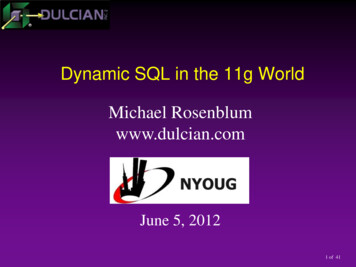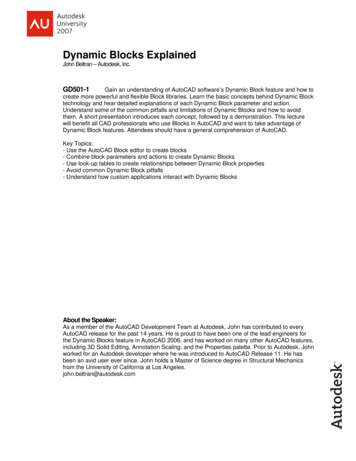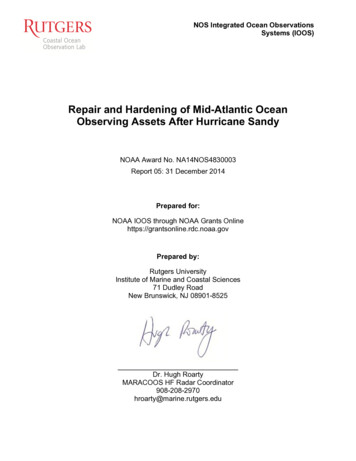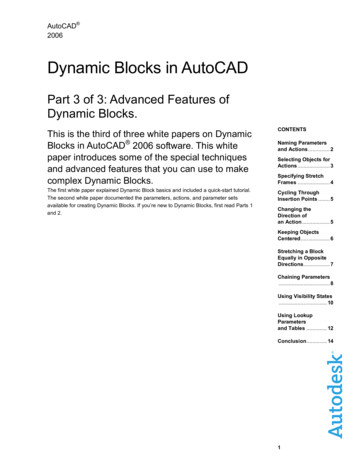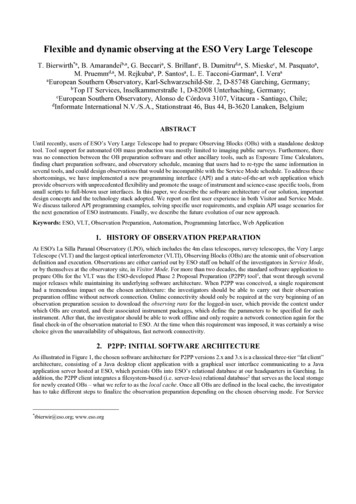
Transcription
Flexible and dynamic observing at the ESO Very Large TelescopeT. Bierwirth*a, B. Amarandeib,a, G. Beccaria, S. Brillantc, B. Dumitrud,a, S. Mieskec, M. Pasquatoa,M. Pruemmd,a, M. Rejkubaa, P. Santosa, L. E. Tacconi-Garmana, I. VeraaaEuropean Southern Observatory, Karl-Schwarzschild-Str. 2, D-85748 Garching, Germany;bTop IT Services, Inselkammerstraße 1, D-82008 Unterhaching, Germany;cEuropean Southern Observatory, Alonso de Córdova 3107, Vitacura - Santiago, Chile;dInformate International N.V./S.A., Stationstraat 46, Bus 44, B-3620 Lanaken, BelgiumABSTRACTUntil recently, users of ESO’s Very Large Telescope had to prepare Observing Blocks (OBs) with a standalone desktoptool. Tool support for automated OB mass production was mostly limited to imaging public surveys. Furthermore, therewas no connection between the OB preparation software and other ancillary tools, such as Exposure Time Calculators,finding chart preparation software, and observatory schedule, meaning that users had to re-type the same information inseveral tools, and could design observations that would be incompatible with the Service Mode schedule. To address theseshortcomings, we have implemented a new programming interface (API) and a state-of-the-art web application whichprovide observers with unprecedented flexibility and promote the usage of instrument and science-case specific tools, fromsmall scripts to full-blown user interfaces. In this paper, we describe the software architecture of our solution, importantdesign concepts and the technology stack adopted. We report on first user experience in both Visitor and Service Mode.We discuss tailored API programming examples, solving specific user requirements, and explain API usage scenarios forthe next generation of ESO instruments. Finally, we describe the future evolution of our new approach.Keywords: ESO, VLT, Observation Preparation, Automation, Programming Interface, Web Application1. HISTORY OF OBSERVATION PREPARATIONAt ESO's La Silla Paranal Observatory (LPO), which includes the 4m class telescopes, survey telescopes, the Very LargeTelescope (VLT) and the largest optical interferometer (VLTI), Observing Blocks (OBs) are the atomic unit of observationdefinition and execution. Observations are either carried out by ESO staff on behalf of the investigators in Service Mode,or by themselves at the observatory site, in Visitor Mode. For more than two decades, the standard software application toprepare OBs for the VLT was the ESO-developed Phase 2 Proposal Preparation (P2PP) tool1, that went through severalmajor releases while maintaining its underlying software architecture. When P2PP was conceived, a single requirementhad a tremendous impact on the chosen architecture: the investigators should be able to carry out their observationpreparation offline without network connection. Online connectivity should only be required at the very beginning of anobservation preparation session to download the observing runs for the logged-in user, which provide the context underwhich OBs are created, and their associated instrument packages, which define the parameters to be specified for eachinstrument. After that, the investigator should be able to work offline and only require a network connection again for thefinal check-in of the observation material to ESO. At the time when this requirement was imposed, it was certainly a wisechoice given the unavailability of ubiquitous, fast network connectivity.2. P2PP: INITIAL SOFTWARE ARCHITECTUREAs illustrated in Figure 1, the chosen software architecture for P2PP versions 2.x and 3.x is a classical three-tier “fat client”architecture, consisting of a Java desktop client application with a graphical user interface communicating to a Javaapplication server hosted at ESO, which persists OBs into ESO’s relational database at our headquarters in Garching. Inaddition, the P2PP client integrates a filesystem-based (i.e. server-less) relational database2 that serves as the local storagefor newly created OBs – what we refer to as the local cache. Once all OBs are defined in the local cache, the investigatorhas to take different steps to finalize the observation preparation depending on the chosen observing mode. For Service*tbierwir@eso.org; www.eso.org
Mode, OBs have to be checked in into the ESO database, after which they immediately become read-only in P2PP’s localcache, so that ESO's User Support Department can safely review the submitted material.If further OB editing is required, the investigator has to check out the OB first, which deletes it from the ESO database,edit it in the local cache and eventually check it back in. Finally, the Service Mode OBs are uni-directionally replicatedfrom the Garching database to the Paranal database, where they are read from by the Service Mode observing tool (OT)and executed.For Visitor Mode, the investigator has to export the OBs from P2PP’s local cache to a text file format (OBX) and savethem on a local disk. If the visitor is present on the mountain and working on a Paranal machine (the traditional VisitorMode scenario), those files are then transferred to the Paranal control network by the Observatory staff via ftp. InDesignated Visitor Mode*, the staff receives the OBX files via email and transfers them internally to the correspondingworkstation. Then, the OBs are re-imported with an additional manual action into the local cache of the Visitor Modeobserving tool (vOT) for execution, again performed by the Observatory staff.Figure 1. Initial ESO software architecture for service and visitor mode observation preparationAs long as we were only supporting so-called loose OBs – as opposed to OBs in scheduling containers – this architectureserved us very well due to two key success factors: *Transactionality of relational databases – Although conceptually the OB is an atomic unit, it has a significantunderlying database schema consisting of a number of tables and relationships. Both when working against theDesignated Visitor Mode observations on Paranal are scheduled on specific dates/slots as if they were regular Visitor Mode runs, butthey are executed by an ESO staff member, in close contact (e.g. via phone, Skype or video link) with the Principal Investigator (PI),or someone the PI designates to serve as the liaison with the Observatory.
local cache as well as when working against the ESO database, we could fully leverage the transactionality ofrelational databases, allowing us to rely on the infrastructure to guarantee that an OB is either fully checked ininto the ESO database or written into the local cache or not stored at all and thereby ensuring that no datacorruption can occur. Simple check-in/check-out paradigm for loose OBs – An OB is only editable in P2PP’s local cache when it ischecked out of the ESO database or when it was never checked in. In both cases the OB does not even exist inthe ESO database. Consequently, complex OB state synchronisation between conflicting OB changes in the localcache and in the ESO database is not needed.3. EVOLUTION OF REQUIREMENTSAfter the initial release of P2PP into production and first operational usage, a number of requirements driven by newscientific needs were incrementally implemented, improving the efficiency of ESO’s user support and the observingexperience at the telescopes. The arrival of the requirement for scheduling containers3 – such as time links, groups andconcatenations of OBs in order to express advanced, longer-term observing strategies – started challenging our softwarearchitecture and implementation, because we could no longer rely on the success factors discussed in the previous section.It became obvious that our software architecture eventually had to fundamentally change due to a number of newrequirements and limitations: Loss of database-level transactionality – Scheduling containers used by large surveys may contain hundredsof OBs and may easily require 15 – 30 minutes to check-in into the ESO database. The sheer number of SQLinserts makes it impossible to execute such a long running action in a single database transaction with potentialrollback in case of errors. We realized that we had to implement our own container-level transaction managementon application level in both the P2PP client and server. For instance, loss of network connectivity during a longrunning container check-in, might lead to a situation in which the P2PP client would not know if the last OBbeing checked in never arrived at the ESO database, or if it did but the acknowledgement was never received. Complex check-in/check-out paradigm for partially executed scheduling containers – The requirement forscheduling containers also implies that an investigator has to be able to edit pending OBs of a partially executedscheduling container. Instead of checking out individual loose OBs, we therefore had to introduce the notion ofchecking out the entire scheduling container into P2PP’s local cache. However, those OBs of the schedulingcontainer that had already been observed, obviously had to remain in the ESO database and could not be deleted.That means with the introduction of scheduling containers consisting of 1 OB, we now had to maintain a statethat could go out of sync in two locations and take care to recover a consistent situation with cross-OBdependencies.Figure 2. Example of a nested scheduling container: time link of concatenations of pairs of a science and calibration OB Nested scheduling containers – Investigators who routinely use concatenations to execute pairs of a science OBand a calibration OB (e.g. for VLTI visibility calibration or telluric correction in IR spectroscopy), would hugelybenefit from being able to specify and execute time links of concatenations of OBs, i.e. containers of containersor nested scheduling containers, as depicted in Figure 2. For example, this would allow them to express relativetime delays between pairs of concatenated science and calibrator OBs to be executed “back to back” in order todesign a time sequence of observations for monitoring the scientific target’s variability. However, evolving thecheck-in/check-out paradigm to support nested scheduling containers would be complex, expensive and notdeliver a particularly intuitive and simple user experience. Programmatic mass production of OBs without P2PP – The only entry point to checking in OBs and containersinto the ESO database remained P2PP. While investigators of large observations such as surveys with hundreds
or even thousands of OBs were happy to be able to use scheduling containers, the direct, fully automated massproduction of valid, verified OBs into the ESO database with a dedicated script or other tool was limited. Theusual workaround was to mass-produce OBs in the export file format OBX, run the P2PP client, manually importthe OBX files into the local cache and finally check them in into the ESO database. This is a rather involvedworkflow that cannot be fully automated and comes at the risk of the OBX file format becoming invalid due tochanging instrument capabilities described in an updated instrument package. While we offer a Survey AreasDefinition Tool4 for observation preparation on the VISTA and VST telescopes that produces dedicated XMLfiles with an equally dedicated import into P2PP to simplify the definition of large surveys, this solution is specificto the definition of survey pointings for these two instruments only and the major limitation of having to manuallyrun P2PP remains. Phase 2 observation preparation essentially remained a “closed shop” with the graphical userinterface P2PP as the only entry point, whereas a part of the community increasingly expressed the need to carryout fully programmatic and automated OB preparation bypassing P2PP. Dynamic OB editing throughout ongoing observing period – The VLT’s new ESPRESSO instrument has theprimary scientific objective to hunt for exoplanets, requiring support for the definition of a prioritized VisitorExecution Sequence of OBs, access to the OB execution status and dynamic, unsupervised real-time editing of(Visitor Mode) OBs throughout the ongoing observing period. For instance, based on radial velocity analysis ofprevious observations, investigators wish to edit OBs and their priority in the Visitor Execution Sequence. Thisis another case where programmatic rather than user interface access to OB preparation fits perfectly. Visitor mode OB transfer to Paranal – The manual transfer of visitor mode OBs to Paranal by means of OBexport to OBX, carried out by the investigator, email/ftp transfer to the Paranal control room and subsequent reimport into vOT by ESO staff, is labour intensive, not a particularly smooth user experience and late editing canonly be done inside the Paranal control room. In particular for designated visitor mode, this is a showstopper forreal-time OB editing by the user at home. Java desktop limitations – The implementation in terms of a Java desktop application led to a number oflimitations. The number of problems caused by different operating systems and Java versions that had to betroubleshot by user support were significant. The rollout of a bugfix or new feature required users to download anew version of P2PP and copy their local cache into the new installation, or even lose the local cache and itscontained OBs in case of incompatibilities with the new version. All of this led to increasing dissatisfaction ofthe community with P2PP’s usability.The points above were the scientific and operational drivers that forced us to entirely rethink our end-to-end phase 2software architecture. While, in fact, we fully implemented the requirement for scheduling containers with thestandalone P2PP and have been observing large surveys on various telescopes such as VISTA and VST makingextensive usage of those advanced observing strategies, we arrived at a point at which the majority of our softwaredevelopment efforts went into the complexity of the above sketched transaction management and statesynchronisation, rather than into delivering scientific and operational value.4. P2: THE NEW SOFTWARE ARCHITECTUREFigure 3 shows a structural view of the new and fully operational software architecture. It was significantly simplified bydropping the requirement to support offline OB preparation. Investigators are expected to have a reasonable public internetconnection. The main architecture and technology decisions are as follows: Web-based observation preparation – The desktop P2PP client application is discontinued. Instead,investigators can carry out observation preparation in a moderately recent web browser (Firefox, Safari, Chrome)executing our single page application p25, a demo of which is publicly accessible at https://www.eso.org/p2demo.This approach minimizes operating system dependencies and provides a zero-install user experience, allowing usto transparently roll out bug fixes and new features without having to ask the community to download a newversion of the application. This is a tremendous advantage that almost naturally allowed us to transition to adevelopment process in which we frequently publish new features in a “devops” spirit, incrementally gatheringand incorporating feedback from selected early users. Additionally, p2 allows to display and edit a VisitorExecution Sequence per user per instrument as shown in Figure 4.
All content created live against the ESO databases in Garching and Paranal – All OBs, including VisitorMode ones, and scheduling containers are immediately created in the ESO database in Garching and bidirectionally replicated to the ESO database in Paranal. The paradigm of checking OBs or containers in and outis entirely discontinued, and consequently the concept of a local cache in P2PP and vOT is no longer needed. Weimplemented a major new release 4 of our Visitor Mode observing tool (vOT) for Paranal, which no longer has alocal cache but reads, creates and edits OBs directly against the Paranal database. Additionally, just like p2, vOT4allows to display and edit a Visitor Execution Sequence as shown in Figure 5. This real time editing isinstantaneously mirrored into the database in Garching via the bi-directional replication. Such feature is especiallyadvantageous for designated visitors who are observing at night while not physically present in the control room.Figure 3. New ESO software architecture for Service and Visitor Mode observation preparation Exposure of business logic as public APIs – Rather than building a monolithic solution with tight coupling ofuser interface and business logic, we strictly separate these two layers. The business logic is exposed in terms ofpublic application programming interfaces (APIs) using the REST6 architectural style, which is lean and simplein both implementation and usage as a client application, very widespread and well understood by softwareengineers. While carefully designed business logic exposed via APIs can be long lived and stable, user interfacetechnologies, specifically on the web, tend to age much faster. This approach ensures complete separation ofobsolescence lifecycles. It is possible to implement a new user interface in a different technology without havingto re-implement the APIs. In addition, REST APIs are perfectly suited for comprehensive test automation withboth functional and non-functional test cases (performance, concurrency, scalability) allowing us to reach highsoftware quality at an early stage and throughout the project by means of continuous integration.The business logic is implemented in a new web server application cop (Creation of OBs and Proposals), thatinitially exposes the phase 2 API only, but is being extended to also expose a phase 1 API for proposal submission.
The complete phase 2 API, with a total of 70 end points, is comprehensively documented online7 using theformal specification language RAML8, so interested investigators can develop science-case specific scripts orother tools. The cop server is implemented using the feature-rich web framework Grails9, a convention-overconfiguration framework that enforces architectural styles and provides powerful abstractions for recurringimplementation tasks such as object-relational-mapping to databases. The amount of technical boilerplate code ismassively reduced, thereby improving code readability and allowing developers to focus on the business problem.We have been using Grails for almost a decade and experienced major improvements in implementationproductivity and maintainability.Figure 4. Visitor Execution Sequence in p2Figure 5. Visitor Execution Sequence in vOT4 Web user interface as single page application using the Angular framework – The increasing adoption ofREST APIs throughout the software industry led to a parallel development of very powerful client-side webframeworks allowing to develop large, dynamic so-called single page applications that are capable of bringingthe rich features of desktop graphical user interfaces to web browsers. We chose to implement our p2 client inGoogle’s Angular framework10 starting with version 2 for several reasons. First, the framework is backed by acomparably large developer community. Considering the alternatives, it covers the widest range of requiredfeatures and – probably most importantly – it allows implementation in the more strongly typed, object-orientedTypeScript11 language, alleviating one of our biggest concerns, the difficult scalability, maintainability andtestability of JavaScript code. After our first release of p2, we also quickly learned that a consistent architecturalpattern for maintaining client-side state is extremely important to ensure UI consistency and minimizedependencies. Therefore, we introduced the ngrx/store client-side state container12 throughout the application.Currently, the number of lines of TypeScript code is approximately 15000 and expected to grow much further.Programming Angular has a significant learning curve and software engineers have to learn and adapt tofunctional reactive programming13. As opposed to our server-side framework Grails, Angular did not boost our
productivity, but it allowed us to realize a dynamic and feature-rich user interface running in the web browserthat was probably unthinkable only 5 years ago.Figure 6 shows p2’s main, desktop-style master-detail view showing observing runs, folders, schedulingcontainers and OBs on the left for navigation purposes, and details of an OB on the right, in turn structured intoa number of navigable tabs. Figure 7 shows an interactive target visibility plot in terms of the target’s airmassover time, the moon elevation and whether requested observation constraints are fulfilled.Figure 6. p2’s main master-detail view showing runs, folders, containers and OBs on the left and OB details on the rightFigure 7. A target visibility plot in p2 showing whether requested observing constraints will be fulfilled
Looking at the phase 2 API from a user interface point of view, we managed to keep the required networkbandwidth low and provide a smooth user experience. Even from Paranal, p2 is reasonably usable with a roundtripdelay to Garching of 260ms and a bandwidth of 1–2 Mbit/s. If needed, the user interface performance can besignificantly improved by executing independent API calls concurrently rather than sequentially. Bi-directional DB replication – The transition from uni- to bi-directional database replication was a majorchallenge. Our fundamental replication approach is asynchronous, i.e. in case of network outage or congestion,pending changes on either side of the Atlantic are buffered in replication queues. This ensures that both sides cancontinue operations in such situations rather than waiting for the opposite side to respond. However, since allVisitor Mode OBs are now also in the databases in Garching and Paranal and can be freely edited either with thep2 web application from anywhere or with vOT in the Paranal control room, there is a certain likelihood thatconcurrent changes to the same OB or to the Visitor Execution Sequence are conflicting, specifically inDesignated Visitor Mode, when the investigator is remotely connected for a visitor night and uses p2. What if thevOT user on Paranal removes a template from an OB while the p2 user at home changes a value in that template?What if the p2 user moves an OB to first position in the visitor execution sequence while the vOT user removessaid OB from the sequence? Our two main rules for replication conflict resolution are (a) delete wins againstconflicting edits regardless of which side triggered the delete and (b) in case of other conflicts Paranal wins. Thisrequired implementation of significant conflict resolution logic in the DB replication infrastructure layer. Thissolution has been used for operations at the telescopes since October 2016 and it works very reliably. Theadvantage of this solution is that any OB created or edited with the p2 web application or the phase 2 API againstthe Garching database is almost instantaneously visible on Paranal. Vice versa, any change carried out on Paranalusing vOT is immediately visible via web application and API. Therefore, the API allows for monitoring of OBstatus and execution progress.5. PROGRAMMING THE PHASE 2 APIThe phase 2 API has to be programming language agnostic so that it can be programmed against in any language, the onlyprerequisite being the availability of an HTTP protocol implementation. Following a REST6 architecture, the API addresseseach resource by a dedicated URL, maps the creation, editing, retrieval and deletion of a resource to the respective HTTPrequest methods POST, PUT, GET and DELETE, and documents each end point in detail7.Figure 8. A simple Python script using the phase 2 API
While this would be enough to start programming, we felt the need to better encourage and promote API usage by providinga Python-specific binding14, i.e. a small glue layer with API methods such as createOB() that simply execute the appropriateHTTP call with the correct method and URL. Given an existing Python installation, the binding can be installed with asingle terminal command pip install p2api and the user is ready to start coding. Figure 8 shows a very basic Python scriptthat first creates a folder under a given observing run, then creates an OB inside that folder, changes the user priority ofthe OB and attaches an acquisition and a science template. We also publish a comprehensive tutorial on how to programthe API in Python7, covering the creation of OBs and scheduling containers, the editing of OBs and their templates, theattachment of finding charts and ephemeris files, the population of the Visitor Execution Sequence, the verification stepsand the final notification of submission to ESO.Some example numbers to illustrate API performance are as follows: in one hour, we managed to import 3000 complexOBs (with attached finding charts and parameter files) using a typical private, asymmetric DSL connection with 6 MBit/sdownstream and 500 kBit/s upstream. To achieve this performance, parallel API calls must be made to saturate theupstream network. Most API calls take less than 250ms, many even less than 100ms. Some bulk calls may take severalseconds up to minutes. The key to good performance is the concurrent execution of independent API calls with up to 4connections to the server.6. PHASE 2 API USAGEThe primary user of the phase 2 API is our own p2 web application. Both the API and p2 have been incrementally rolledout into production. Visitor Mode is already fully operational for all Paranal instruments, while Service Mode is operationalon UT2, VISTA and VST since early 2018, and will be extended to the remaining instruments by Q3 2018. We will soonbe able to decommission the P2PP version 3 client and server. Work is already underway to also upgrade our La Sillaobservatory site to the infrastructure described in this paper, which will allow us to finally decommission P2PP version 2as well.Another major API client is ESO’s unified GuideCam Tool15, our platform to realize instrument-specific observationpreparation requirements that go beyond what can be accomplished in p2, such as guide star selection, stepping throughtelescope offsets and the production of finding charts. For the foreseeable future, the GuideCam Tool remains a Javadesktop application, since it integrates and heavily relies on the Aladin Sky Atlas16. Currently, the GuideCam Tool supportsthe VLT instrument VIMOS, VISIR, HAWK-I and MUSE, and support for more VLT instruments will incrementally beadded. In order to work with an existing OB, the user selects the OB in p2 and then opens the GuideCam Tool. In theGuideCam Tool window, there is a button that fetches the OB from p2 (also connecting to P2PP version 3 and vOT version4). Upon pressing this button, the OB details (pointing coordinates, instrument, observing mode) are retrieved andGuideCam displays the image of the sky and the focal plane setup, allowing the user to select the guide star, adjust thepointing coordinates, position angle, offsets, or blind acquisition parameters for a faint target. When the user has completedthe work in the GuideCam Tool, all produced information, such as guide star coordinates, telescope offsets and findingcharts, can be pushed back to the OB with a single button press. This entire workflow is enabled by the phase 2 API.Another API usage scenario is the Python script fcmaker17 that produces custom MUSE and HAWK-I finding charts andattaches them to OBs.For future survey facilities at ESO – e.g. MOONS, 4MOST – it is expected that mass OB production via API will be avery useful and indeed indispensable feature.We would like to emphasize that both a p2 user interface demo18 and a phase 2 API demo19 with a dedicated tutorialaccount are publicly available. This demo environment is entirely separated from our operational one for reasons of securityand production data integrity. It can be safely used to learn how to program against the API, to experiment with observingstrategies and feasibility, and to train new users.7. SUMMARY & OUTLOOKWe have made a major progress in realising our technical strategy to prefer web over desktop development wheneverpossible, to separate UIs from business logic and to make our business logic publicly available for creative and sciencecase specific usage by exposing it via carefully designed APIs. All OBs, regardless of whether they are Service or VisitorMode, are available in the two ESO databases in Garching and Paranal which are fully synchronized in near real time, sothat edits on either side are almost instantaneously visible on the other side. Visitor Mode OBs are now also seamlessly
transferred to the Paranal control room and can be quickly and easily modified. A Visitor Execution Sequence per userand instrument is available to support dynamic adjustment of observation priorities, for on-site and designated VisitorMode.We have now reached a modern, sustainable and extendible software architecture that enables us to implement a widerange of observing strategies in a user friendly, adaptive and scalable way. The introduction of the phase 2 API paves theway for also exposing instrument-specific observation preparation features (e.g. optimize adaptive optics performance,find instrument guide stars) implemented by the community as scriptable APIs, rather than shielding such functionalityaway in a desktop tool inaccessible for scripting. For Service Mode OBs, the introduction of nested containers will allowus to much more easily enable typical observing strategies for VLTI and NIR spectroscopy. Furthermore, we will updateour tools to more adequately prioritize adaptive optics observations on site.An important future development is to expand the integration with other tools, such as the upcoming new Phase 1 Propos
scientific needs were incrementally implemented, improving the efficiency of ESO’s user support and the observing experience at the telescopes. The arrival of the requirement for



